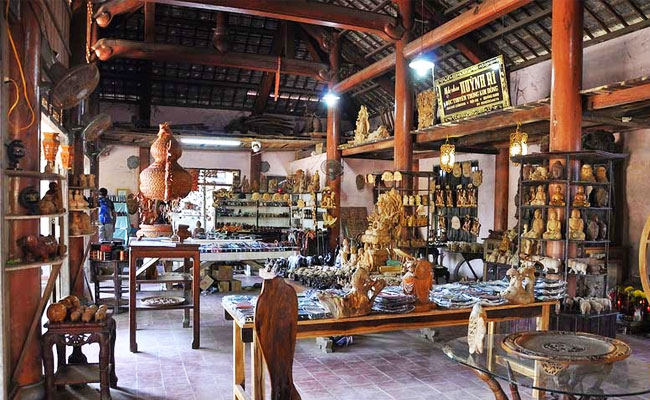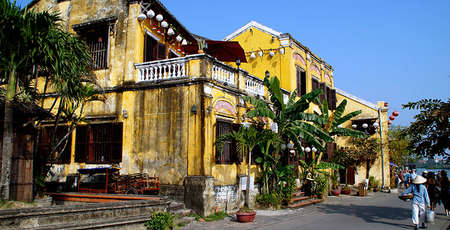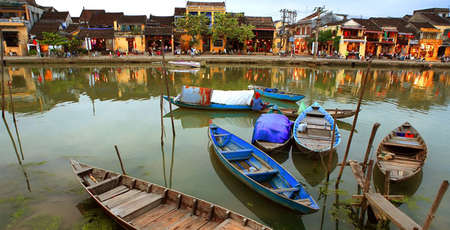
Hoi An carpentry village (Kim Bong)
- on Feb 25, 2018 By: Ngoc Tu DINH
On the opposite side of Hoai River, to the East of Hoi An Ancient town in Quang Nam province, located a traditional carpentry village named Kim Bong. The craft products of Kim Bong village was extremely famous in the 15-16 century among the crowded port of Hoi An. Undergoing hundreds of years of existence and development, Kim Bong carpentry village has built the core value for it’s brand name with various of products bearing the charms of ancient Hoi An.

Since the 16th century, the village of Hoi An has concentrated on wood products and become famous for roundhouse goods, making boats and constructing pagodas. The products of Kim Bong Village also sold in big cities in Vietnam and worldwide.

Hoi An central harbor was the place where rich merchants of Nguyen Dynasty undertaking commercial activities. Due to the prosperity of regional trading, local people learnt and heritage the techniques of making boats from Cham people as well as the methods to make household wood products and architecture from Chinese and Japanese.

In the 18th century, Kim Bong Wood Village formed 3 separated sections. The wood construction did not only help defined the architecture of Hoi An ancient streets and leave a remarkable style for well-known historical monuments in Da Nang and Hue but also brought to the international market. The art of making boats for international trading require local people to master the techniques for making big scale boats. The sector of wood product for household usage developed to high a technical level that allowed local people to generate beautiful products. In addition, the art of impasto and craving mascots also contributed to make Kim Bong become a famous trade village of Vietnam.
Nowaday, though the prosperous period of Kim Bong passed, the artists of this village still contribute their talents to restore and conserve the historical monuments in ancient streets and travelling to different regions to build traditional houses. In addition, the art of making wood products also developed quickly since the tourism strategies were implemented in this village.

Visiting Kim Bong is an opportunity for tourists to directly observe the production of wood products, especially the impressive craving process by high-skilled local artists. In addition, visitors can also take time to look at the exhibitions of unique artworks like: the censer craved with 1000 dragons by the image of a stoned bamboo, Cau pagoda in Hoi An. Furthermore, visitors can also buy some typical specialities of the region as souvenir.
While some wood villages in the North are influenced by the feudalism of Chinese culture, Kim Bong Wood Village still keeps its gentleness, simplicity and elegance. Theses characteristics were reflected on the craving pillars with flower and leaf patterns, in the air of ancient streets of Hoi An or other regional products.
The people of Kim Bong Village are still travelling to different regions in Vietnam to build traditional houses. The members of Huynh family - one of the most four well-known families (Huynh, Truong, Phan, Nguyen) who contributed to the establishment of this village, are very proud of their senior member - Mr. Huynh Kim Hon, who participated in the process of building Ho Chi Minh Mausoleum.
Coming to Kim Bong Village, you can visit several workshops of local wood artists and directly observe their activities in creating beautiful products. These workshops are also the space for exhibiting unique artworks including: the censer craved with 1000 dragons on the image of a stoned bamboo and displayed on the celebration of Thang Long 1000 years in Hanoi, the re-illustration of Bridge Pagoda in Hoi An. In 2016, Kim Bong was also recognized as a national intangible heritage.
In addition to the above activities, visitors can also rent a bike and start explore Kim Bong Village to see how local people live, visit the temples and observe the daily agricultural tasks such as: weaving mats, making bamboo baskets, making “bánh tráng” - rice paper wrappers.

A festival to celebrate the traditional craftsmanship of this village is an interesting event of Hoi An - organized annually on the January 6th (Lunar Calendar) at Tien Hien Temple of the village.
Comment
Other Blog
Categories
Latest News
on 31 Dec, 2025
on 31 Dec, 2025
 Español
Español Français
Français




















Morgane Ter Cock
on Dec 18, 2025HerbertPhomaMS
on Oct 19, 2025Lilyan Cuttler
on Oct 15, 2025Avenue17XC
on Sep 14, 2025Avenue18JL
on Jul 21, 2025